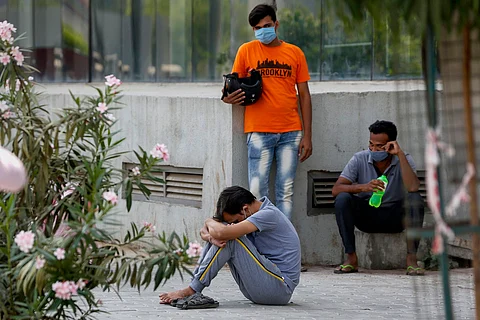

India reported over 2 lakh COVID-19 cases on Thursday morning, the highest in a single day so far, according to the Union Health Ministry. The country’s second wave has seen COVID-19 spread alarmingly faster compared to last year, with a number of states seeing their daily highs being broken almost every day. While some experts have blamed new variants for driving the second wave, others have pointed to people’s failure in adhering to COVID-19 appropriate behaviour such as wearing face masks, physical distancing and hand hygiene.
But beyond the numbers, how different is the COVID-19 second wave in India? Are doctors seeing any worrying patterns or clinical presentations in COVID-19 patients this year? TNM spoke to several doctors to find out if there are any new warning signs people should watch out for in 2021, compared to the first COVID-19 wave.
As far as clinical symptoms go, most doctors say they have not seen any new or different symptoms from the first wave. The most common symptoms, according to the US Centers for Disease Control and Prevention, are fever, cough, shortness of breath, fatigue, body ache, sore throat, diarrhea, vomiting, loss of smell or taste.
Dr P Vasanthamani, Dean of the Kilpauk Medical College (KMC) in Chennai, says although the hospital is not seeing different clinical presentations of the COVID-19 disease, there have been many patients complaining of diarrhea of late. Dr A Nirmala, Dean of Coimbatore Medical College, says individuals should not ignore symptoms such as vomiting or diarrhea. “Apart from the usual symptoms, we sometimes have COVID-19 patients presenting with diarrhea. Some patients also come with vomiting and headache. They should not ignore vomiting or diarrhea and should get a test done at the earliest,” says Dr Nirmala.
Dr E Theranirajan, Dean of the Rajiv Gandhi Government General Hospital (RGGGH) in Chennai, says the second wave has seen a lot more symptomatic patients. “Earlier, the asymptomatic case percentage was high. Now it’s less. This is a big problem. We were able to send them to COVID Care Centres before. Now we are not able to send them there.” RGGGH, which is one of biggest hospitals in Tamil Nadu, has 1,618 beds exclusively for COVID-19 patients. The Dean says that as of Thursday, over 975 of these beds are occupied.
With COVID-19 having varied clinical manifestations, Dr Vasanthamani emphasises the importance of getting a test, however mild the symptoms. She explains that KMC does not rely only on an RT-PCR test, considered the gold standard for COVID-19 diagnosis, to determine a positive case. Instead, the hospital uses RT-PCR, CT scan and a blood test to diagnose a COVID-19 patient. “The RT PCR may be negative, but the CT scan may be positive. Or CT plus blood panel may be positive, or CT is negative, and COVID-19 test and blood panel may be positive. All these three need to be taken into consideration. If any two are positive, we have to treat them as coronavirus positive,” she explains. However, Dr Theranirajan warns that patients should not undergo CT scans without first taking an RT-PCR test. “Don’t take CT first and then come to the hospital. Because of stigma and fear, patients don’t want to take RT-PCR as the first line of investigation. They want to directly go to CT. Unnecessarily, you are exposing your body to radiation. CT scan has to be decided by doctors not by patients.”
What’s worrying doctors like Vasanthamani this time is that the course of the COVID-19 disease appears to have shortened. “Mild symptomatic patients are suddenly — without any premonitory symptoms — directly showing lung involvement,” she observes, “Previously, lung involvement was seen on the seventh or eighth or ninth day. Now we are seeing severe lung involvement with mild symptoms on day four, or day five.”
Dr Theranirajan says that more than clinical symptoms, it’s the radiological presentations that have changed in second wave COVID-19 patients. “Earlier we used to get more ground glass appearance and other things in the lungs. Now we are getting a nodular pattern of presentation. There is more opacity in the lungs. This was usually a diagnosis for malignancy (lung cancer).” He, however, notes that the treatment protocol for such patients has not changed.
Doctors say that compared to 2020, they are now seeing younger patients in hospitals. Dr Radhakrishna, Medical Superintendent of CV Raman General Hospital in Bengaluru, says, “Now we are seeing a younger age group becoming positive. Young adults of 18-20. Maybe because they are out a lot without considering risks. They are lowering their guard. Maybe it’s because in the first wave, they didn’t get affected, they are getting affected now.” He, however, adds that most of these patients recover well.
In Chennai as well, Dean of RGGGH, Dr Theranirajan says, “We are seeing patients 35 and above. The symptoms are the same, they are presenting with pneumonia, with respiratory failure. Most of them come with oxygen requirements. They die only of respiratory failure. If they go for any infection, only then we see multi-organ failure.” Tamil Nadu Health Secretary J Radhakrishnan had earlier stated that 50% of the cases in the state were of people between the ages of 18 and 45, while those under the age of 18 accounted for 8% of cases.
Both Dr Radhakrishna and Dr Theranirajan say that the key difference in the second wave is in the nature of the spread of the infection “The only difference I see now is that there are more clusters. If one person becomes infected now, the whole family becomes infected. We see five or six in a family testing positive, it was not seen earlier,” says Dr Radhakrishna.
Dr Therarnirajan also says that Chennai is seeing mostly family clusters rather than community outbreaks. “It shows that mostly family functions have caused the high rate of infections,” he says, appealing to people to avoid mass gatherings as well as family functions and to adhere to COVID-19 protocols.